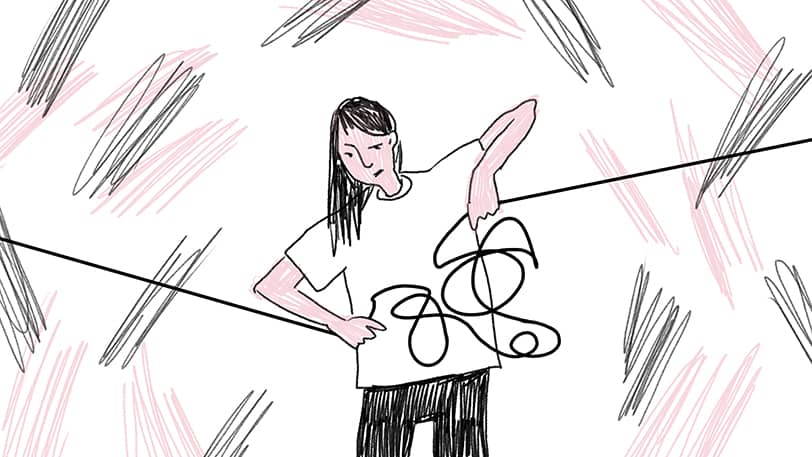Perfectionism is not just a desire to do everything well, but an obsessive need to bring any task to flawless completion, accompanied by harsh self-criticism. At first glance, this quality seems like an advantage: is it bad to want a perfect result? But the paradox is that the closer a perfectionist gets to their goal, the more acutely they feel dissatisfaction. Instead of joy from achievements—disappointment, because “it could have been better.” Instead of pride—fear of mistakes, since any small detail can “ruin” the ideal.
Take, for example, a student who rewrites their notes at night because their handwriting seems insufficiently neat. Or a designer redoing a project dozens of times, even though the client approved the first version long ago. These people are not just hardworking—they are locked in a cage of their own inflated standards. Their inner critic denies them the right to make mistakes, turning even minor flaws into proof of “inadequacy.” And here’s the question: why does this happen? Why, as we become more skilled and experienced, do we not soften our demands on ourselves but instead tighten them?
The root of the problem lies in distorted perception. A perfectionist lives in a world where “ideal” is not a guideline but the only acceptable option. Each new achievement does not bring satisfaction but only raises the bar: yesterday’s “ceiling” becomes today’s “minimum.” Social media pours fuel on the fire, creating the illusion that everyone around is accomplishing more, doing better, and living brighter. As a result, even objectively high achievements are devalued, and the person themselves feels perpetually behind.
This article is an attempt to understand the mechanism of perfectionism, which transforms from an engine of progress into fuel for self-flagellation. How can we break the vicious cycle in which growing mastery leads not to confidence but to anxiety? And is it possible to learn to value oneself not in spite of imperfections but alongside them?

How Perfectionism Works: The Mechanism of Eternal Dissatisfaction
Perfectionism often masquerades as a virtue—after all, is it bad to strive for the best? But in reality, it’s a cleverly constructed trap that doesn’t let go even of the most successful people. Instead of celebrating achievements, a perfectionist notices only the flaws. Instead of pride, they feel frustration because “it could have been better.” This isn’t just high self-expectations—it’s a full-blown system of self-punishment that operates by its own rigid rules.
Why does this happen? The thing is, perfectionism isn’t about real standards—it’s about a distorted perception of oneself and the world. It forces a person to run an endless race where the finish line keeps moving further away. Each new success doesn’t bring relief but only heightens anxiety: “What’s next?” Let’s break down exactly how this mechanism of eternal dissatisfaction works and why it’s so hard to recognize.
The Shifting Goal Effect
Imagine you set yourself a goal—say, to complete a project with an “excellent” grade. You’d think that once achieved, you could exhale and celebrate. But a perfectionist doesn’t work that way: as soon as the goal is reached, they immediately set a new, even more difficult one. “Excellent” turns into “perfect,” then into “brilliant,” and eventually into “something unattainable.”
This effect is familiar to athletes, artists, scientists—anyone constantly developing in their field. But while a healthy approach allows celebrating small victories, a perfectionist simply doesn’t notice them. Their brain is wired in such a way that any achieved milestone instantly loses value. As a result, the person lives in a state of chronic dissatisfaction, even when objectively successful.
Hyperfocus on Mistakes
A perfectionist can do a hundred things flawlessly, but their attention will latch onto a single mistake. And the more insignificant the error, the more it irritates them. A typo in an email, a slight stumble during a presentation, a not-quite-perfect shade in a design—all of it becomes proof of “insufficient” professionalism.
Psychologists call this “negative attentional bias”: a perfectionist’s brain automatically zooms in on failures while ignoring successes. The result is a distorted reality where minor flaws overshadow all achievements. It’s like looking at a painting through a magnifying glass, noticing only the cracks in the paint but missing the image itself.
Comparison with Others
Social media, professional circles, even casual conversations with colleagues—all become sources of stress for a perfectionist. They constantly measure themselves against others’ standards, and they don’t compare themselves to real people but to their “edited” versions.
The problem is that a perfectionist compares their inner struggles to others’ external achievements. They see someone else’s success but not the fears, doubts, and failures behind it. As a result, they feel like “everyone else is doing better,” even when that’s far from the truth.
Cognitive Distortions
A perfectionist’s thinking operates on an “all or nothing” principle: either perfect or a failure. There are no in-between options. Here are some typical thought patterns that distort perception:
- “I must do everything flawlessly”—but no one can meet such a standard all the time.
- “If it’s not perfect, it’s bad”—devaluing any results short of absolute.
- “A mistake = disaster”—exaggerating the consequences of even minor slip-ups.
These mental templates force a person to live in a state of constant stress. Even a slight deviation from the “ideal” is perceived as a personal failure, not a natural part of the process.
Perfectionism isn’t just high standards—it’s a system that replaces growth with self-flagellation. It forces a person to run in circles, where each new goal only deepens dissatisfaction. Recognizing these mechanisms is the first step to breaking free from the prison of one’s own demands.

Why is this a paradox?
At first glance, it seems logical: the better a person becomes at something, the more confident and satisfied they should feel. But with perfectionism, the opposite happens—growth in skill doesn’t bring relief but only intensifies inner tension. This is the core paradox: instead of enjoying the fruits of their labor, the perfectionist falls into a trap of perpetual dissatisfaction, where each new level of mastery becomes a new form of torment.
This contradiction is especially noticeable when comparing a perfectionist to an ordinary specialist. An ordinary person, when learning a new skill, celebrates progress: “Yesterday I couldn’t do it, but today I can!” The perfectionist thinks differently: “Yes, now I can do it, but why not as well as that expert online?” It turns out that growth doesn’t free them from self-criticism but only shifts its focus.
The higher the level, the stricter the self-demands
A perfectionist is like a mountaineer who, upon conquering each peak, doesn’t rejoice in the achievement but instead notes with disappointment: “This mountain wasn’t high enough.” This is especially evident in professional growth. A beginner might allow themselves to celebrate small victories, but the more experienced a person becomes, the more details they notice and the harsher they judge themselves.
For example, an amateur musician might be happy to learn a simple melody. A professional, however, will torment themselves over the slightest off note in a virtuoso piece. Meanwhile, others might admire their performance, but the perfectionist hears only the flaws. This creates a painful dissonance: outwardly, the person achieves success, but inwardly, they feel like a failure.
Psychologists explain this phenomenon as a reverse “Dunning-Kruger effect”: the more competent a person becomes, the more they recognize the limits of their mastery and the stricter they judge themselves. But while a healthy specialist accepts this as part of professional growth, the perfectionist sees it as a personal failure.
Perfectionism ≠ high achievement
There’s a widespread myth that perfectionism is the engine of success. In reality, research shows the opposite: the obsessive pursuit of perfection often hinders rather than helps. Scientists identify two main negative effects:
-
Procrastination – the fear of not doing well enough leads to constant delays. “I’ll start when I’m fully prepared” turns into endless “preparation” that never transitions into action. This is especially noticeable in creative fields: a writer spends years “polishing” a single chapter, a designer redoes a project dozens of times, a scientist doesn’t publish research, deeming it “not thorough enough.”
-
Burnout – constant tension and self-criticism drain emotional resources. Unlike healthy diligence, where there’s room for joy in the process, the perfectionist works themselves to exhaustion, never allowing a moment of relaxation. This leads to chronic fatigue, loss of motivation, and even depression.
The irony is that people with moderate standards often achieve more because they aren’t afraid to act, make mistakes, and learn from them. The perfectionist, however, gets stuck in a cycle of “preparation-doubt-self-flagellation,” which hinders real progress.
Example: The scientist who doesn’t publish their work because it’s “not perfect yet”
This classic example perfectly illustrates the paradox of perfectionism. Imagine a researcher who spends several years conducting a complex experiment. The data is collected, the conclusions are drawn, but… publication is endlessly postponed. They need to double-check the calculations one more time. Add another control study. Rewrite the introduction. Compare it with colleagues’ latest papers.
Months, years pass. Colleagues who worked with less “perfect” data have already defended their dissertations and secured grants. Meanwhile, our perfectionist keeps polishing their work, which seems increasingly flawed with each passing day. At some point, the research even loses relevance.
This is the tragedy of perfectionism: the pursuit of flawlessness doesn’t bring one closer to the ideal but instead distances them from real achievements. Fixation on details obscures the bigger picture—that the work is already good, that it has value here and now, not in some hypothetical “perfect” version.
The paradox of perfectionism is that it turns growth into an endless race without a finish line, where you can’t stop and can’t win. The more a person knows and can do, the more painfully they realize how much they still don’t know. The higher they climb, the stricter they become with themselves. And instead of enjoying the fruits of their labor, they doom themselves to eternal dissatisfaction.
Recognizing this paradox is a crucial step toward a healthier relationship with oneself and one’s work. Perhaps real progress lies not in reaching a mythical ideal but in learning to appreciate what already exists—while continuing to grow, but without self-flagellation or fear of imperfection.

Consequences: Why Chronic Self-Dissatisfaction is Dangerous
Perfectionism is often romanticized as a path to excellence. But behind its attractive facade lies an exhausting reality: a constant inner struggle that slowly but surely erodes mental and physical health. When a person lives in a state of chronic self-criticism for years, it doesn’t go unnoticed. The body and psyche begin to malfunction, like a computer operating at maximum capacity without ever rebooting.
The main danger of perfectionism is that its consequences unfold gradually. At first, it seems like you’re just a “responsible person with high standards.” Then you notice you’ve stopped enjoying your work. Next comes constant fatigue. And one day, you realize life has become unbearably hard, but you no longer have the strength to change anything. It’s like a slow-acting poison—invisible at first but devastating in the long run.
Emotional Burnout (Chronic Tension)
Imagine an athlete who trains nonstop, ignoring pain and exhaustion. Sooner or later, their body will give out. The same happens to a perfectionist’s psyche. Their brain operates in constant “high alert” mode: analyzing mistakes, hunting for flaws, planning improvements. No breaks, no relaxation—just endless control.
The symptoms of burnout in perfectionists are especially insidious:
- Chronic fatigue that doesn’t go away even after rest.
- Loss of motivation—what once inspired now only irritates.
- Cynicism toward one’s own work (“nothing will ever be perfect anyway”).
- Declining productivity—the paradox of trying harder but performing worse.
What’s particularly alarming is that perfectionists often burn out amid external success. Others see a high-achieving individual, unaware that inside, they’re empty and depleted.
Anxiety and Depression (Feeling Like a Failure Despite Success)
A perfectionist’s brain is wired to quickly devalue achievements while magnifying mistakes. Over time, this distorts their perception of reality: objectively successful, yet subjectively feeling like a failure.
How it manifests:
- Anxiety appears as constant worry about potential mistakes.
- Depressive episodes arise from the sense that “nothing is ever perfect.”
- Emotional swings—from the high of achieving a goal to deep disappointment hours later.
- Physical symptoms—insomnia, headaches, stress-related digestive issues.
The saddest part? Perfectionists rarely seek help, dismissing their struggles as “normal” or “deserved.” Meanwhile, their mental state continues to deteriorate.
Procrastination (“If I Can’t Do It Perfectly, I Won’t Even Start”)
The irony is that the pursuit of perfection often leads to total inaction. The fear of not being good enough paralyzes, making it terrifying to begin. It’s like refusing to enter the water because you can’t swim flawlessly.
The mechanism of perfectionist procrastination:
- Setting unrealistically high standards.
- Realizing how hard they are to meet.
- Fear of falling short of the ideal.
- Delaying the task (procrastination).
- Guilt over procrastinating.
- Compensating by setting even higher standards.
A vicious cycle forms: the more you delay, the more perfect the eventual result must be. And the higher the standards, the scarier it is to start.
Relationship Problems (Imposing Your Standards on Others)
Perfectionism rarely stays confined to one person. Eventually, those impossible standards get applied to others: partners, children, colleagues, friends. This creates serious interpersonal difficulties.
How it plays out:
- Hyper-criticism—inability to accept others’ flaws.
- Control issues—demanding everything be done “right” (i.e., “my way”).
- Resentment toward those who “don’t try hard enough.”
- Isolation—when maintaining relationships becomes too draining.
Romantic relationships suffer most. A perfectionist’s partner often feels perpetually “not good enough,” while children may grow up believing love must be earned through flawless behavior.
The consequences of perfectionism resemble dominoes—one issue triggers the next. It starts with harmless “I just want to do well” and ends with emotional exhaustion, anxiety disorders, lost productivity, and loneliness.
The cruelest part? Many only grasp the scale of the problem when the damage has already severely impacted their quality of life. That’s why it’s crucial to recognize the warning signs early and cultivate a healthier relationship with oneself and one’s achievements.
Research shows that those who overcome toxic perfectionism not only become happier but—ironically!—start achieving more. Because they finally free up the energy once wasted on self-flagellation and channel it into real growth.

How to Break the Cycle of Self-Criticism?
Perfectionism creates a vicious cycle: the more we criticize ourselves, the worse our results become, and the more intense the self-criticism grows. Breaking this loop isn’t easy—it’s been reinforced in our minds for years. But the good news is that even the most hardened perfectionist can learn to treat themselves with more kindness. This doesn’t mean “lowering the bar” or “becoming less responsible.” It’s about shifting from destructive self-criticism to healthy self-discipline.
The first step is understanding that self-criticism doesn’t make us better. Research shows that people who practice self-compassion achieve greater success than those who constantly berate themselves. Why? Because they don’t waste energy on self-flagellation—they channel it into real action.
Realizing That “Perfection” Is an Illusion
Nearly all great achievements in human history were accompanied by mistakes and failures:
- Thomas Edison made 1,000 failed lightbulb prototypes before succeeding.
- J.K. Rowling received 12 rejections before Harry Potter was published.
- Walt Disney was fired from a newspaper for “lacking imagination.”
Try this exercise: pick any field where you consider yourself an expert and study its history. You’ll find that progress always came through trial and error. Perfection isn’t a destination—it’s a constantly moving horizon.
The “Good Enough” Method
Instead of asking, “How can I do this perfectly?” ask yourself:
- What is the minimum acceptable result?
- Which criteria truly matter?
- What can be considered “good enough” under these circumstances?
Example: Instead of “Write the perfect article,” aim for “Communicate key ideas clearly, fact-check, and meet the deadline.” Define specific, measurable criteria for what “good enough” means for your task.
Working With Your Inner Critic
Techniques from cognitive-behavioral therapy:
A. Identifying the Critical Voice
- Write down self-critical thoughts verbatim.
- Note which situations trigger them.
B. Reality-Checking
- Is this a fact or an opinion?
- Would I say this to a friend?
- What evidence supports or contradicts this thought?
C. Reframing
Replace “I must do this perfectly” with:
- “I’ll do my best to do this well.”
- “I allow myself to make mistakes.”
- “The most important thing is to start—I can improve later.”
Focus on the Process, Not the Outcome
The “small steps” approach:
- Break the task into tiny actions (e.g., not “write a report” but “open the document”).
- Focus only on the current step.
- Acknowledge progress after each micro-action.
Example for a writer:
- Day 1: Open the document.
- Day 2: Write three sentences.
- Day 3: Add another paragraph.
This method bypasses resistance caused by fear of an imperfect result.
Gratitude for Progress
Keep an achievement journal using this format:
- What I did today (even small steps).
- What I learned (including “failures”).
- What I can praise myself for.
Key rules:
- Record concrete facts.
- Focus on effort, not just outcomes.
- Re-read entries during moments of self-criticism.
Practical Advice for Today
Pick one small task you’ve been putting off due to fear of imperfect execution. Apply the “good enough” method:
- Define minimum success criteria.
- Break it into micro-steps.
- Complete the first step right now.
- Note progress in your journal.
Remember: Escaping perfectionism isn’t a one-time event—it’s a gradual process. Every time you notice self-criticism and choose a gentler approach, you weaken its grip. Over time, new thought patterns will become habitual, and you’ll find you can achieve more with less stress.

Conclusion
Perfectionism is a deceptive magnet that attracts us with promises of flawlessness but ultimately leaves us feeling perpetually “not enough.” We’ve grown accustomed to believing that self-criticism motivates, that high standards lead to success, and that striving for perfection makes us better. But in reality, the opposite proves true: the more we chase impeccability, the more we miss the very essence of life—the ability to appreciate what we already have, value our efforts, and allow ourselves to be human rather than error-proof machines.
The fundamental paradox is that growth and development never follow a linear, perfect trajectory. Look at nature: trees grow crooked, rivers carve winding paths, and the most breathtaking landscapes often emerge from chaos. Our mistakes, “flaws,” and moments of imperfection aren’t obstacles on the path—they are the path. They’re what make us adaptable, teach us resilience, and ultimately lead us to unconventional solutions that someone bound by a “perfect” plan would never discover.
So where’s the line between healthy pursuit of quality and toxic perfectionism? The answer is personal. For one person, “good enough” might mean completing work on time, even with minor imperfections. For another, it’s the ability to say, “I did my best,” without comparing themselves to others. And for a third, it’s simply going to bed on time instead of reworking an already-good project until dawn.
Today, try taking one small step toward treating yourself more gently. Maybe it’s consciously deciding not to proofread an email for the tenth time before sending it. Or experimenting with intentionally leaving a small flaw in your work, just to test: will the world really collapse because of it? Each such step isn’t a compromise—it’s liberation. Liberation of energy you can redirect toward what truly matters: creativity, relationships, new experiences, or simply a life that leaves room not just for achievements but for joy.
Perfectionism robs us of too much. But the good news is you can exit this race at any moment—just by taking a deep breath and giving yourself permission to be good enough right now. Not perfect. Not flawless. Just real.




